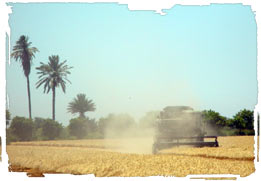CIMMYT E-News, vol 2 no. 10, October 2005
 A new study from the Carnegie Institute of Washington, Stanford University, and CIMMYT shows wheat yield gains in northern Mexico could be due mostly to the weather.
A new study from the Carnegie Institute of Washington, Stanford University, and CIMMYT shows wheat yield gains in northern Mexico could be due mostly to the weather.
Since the beginning of the Green Revolution in the 1960s Mexico has seen a continuing rise in average wheat yields. At the end of the 20th century yields were 25 percent higher than they were in 1980. It started with the improved wheat that Dr. Norman Borlaug developed during the 1940s and 50s in the Yaqui Valley of Mexico’s Sonora State.
CIMMYT scientists and partners have tracked yield trends in the area for decades, noting changes in varieties, cropping practices, disease pressures, and even policy changes that might have an impact on the final tonnage a farmer gets from the field. Trends observed here, in the cradle of the Green Revolution, may be good indicators for other parts of the wheat producing world.
CIMMYT agronomist Dr. Ivan Ortiz-Monasterio and his colleagues from Stanford University were curious to evaluate the most significant factors in that yield gain. But before they could look at the contribution of fertilizers or improved varieties, they decided to eliminate any impact that changes in climate might have had. This is no easy task, and often in calculations in the past, the weather was assumed to have been relatively constant and therefore would not affect a trend in yield.

By taking climate into account, the team came up with a surprising result, one that has long-term implications in a world where global warming is likely a major part of ongoing climate change.
Taking detailed weather data from 1987 – 2002 recorded at two weather stations close to farms whose output of wheat per hectare was well documented, they used a computer model for how wheat grows to simulate what would happen to wheat yields using the real weather data and leaving every other potential impact constant. The result was that from 85-100% of all the change in wheat yield could be explained by the climate.
“Basically a two-degree change in temperature accounted for nearly all of the yield change,” says the Carnegie Institute’s Dr David Lobell, the principal author of the study.
The study found that the nighttime temperature had the most significant impact on wheat yield. The weather data showed that over the 15-year period there had been a gradual trend toward cooler nights. During that time, farm yields in the areas studied in the Yaqui and Mayo Valleys (Sonora State) and in the San Luis and Rio Colorado Valleys (Baja California) increased from below 5 tons / hectare to about 6 tons / hectare, a significant increase.
“Although higher yielding wheat varieties were developed during the 15 years of the study, these were not widely grown by farmers in the region,” says Dr. Ortiz-Monasterio. “This was due to the breakdown of disease resistance or bread making quality limitations.”
Not satisfied with a result based on a single computer model, the team decided to try a second approach to get at the impact of temperatures on production. Again, the independent analysis produced very similar results.
The new study, published in the current issue of Field Crops Research and supported by the National Science Foundation and the Packard Foundation, has important implications for directions in wheat research. Climate changes, in particular increases in average temperatures, could have important, negative effects on wheat yields in the future.
For further information, contact Ivan Ortiz-Monasterio (i.ortiz-monasterio@cgiar.org).
 Capacity development
Capacity development 
